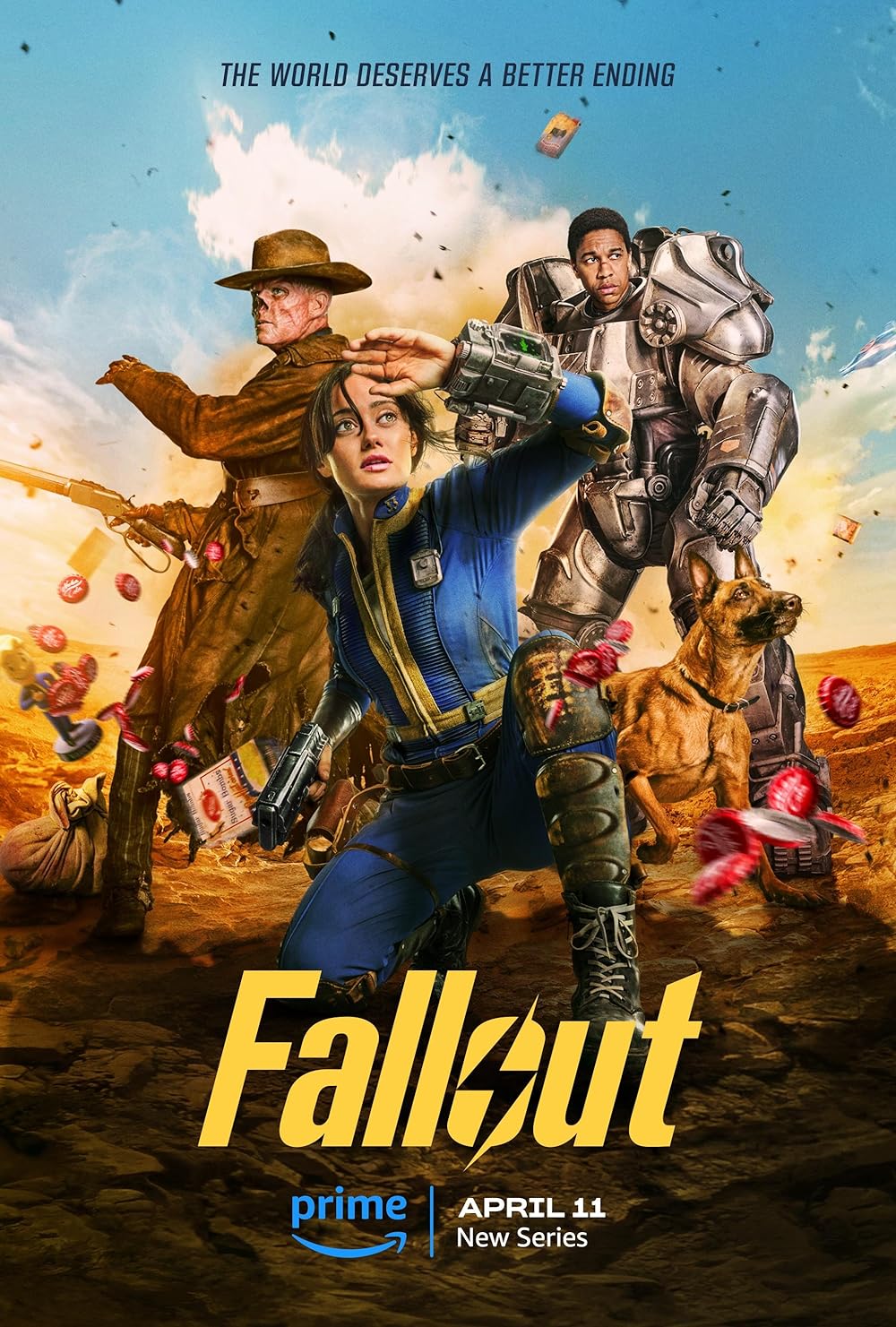Image: Poster via IMDb
An irradiated, post-apocalyptic California. A chipper and naive young heroine. A squire with flexible ethics and ambitions to become a Knight. A deadly bounty hunter from a bygone era, with a mean streak. And a microchip with the power to change the world. All these things and more describe the dark yet lively world of Prime Video’s latest and highly anticipated new show: “Fallout” (2024).
Video game adaptations have been going through a renaissance as of late, with such hits as Max’s (formally HBO Max) “The Last of Us” (2023), Netflix’s “Arcane” (2021) and “Cyberpunk: Edgerunners” (2022). Not to say they have all been winners though, as seen with Netflix’s abysmal “Resident Evil” (2021). With such huge franchises being adapted, it was only a matter of time before Bethesda Game Studios’ “Fallout” became either a major motion picture or a TV show.
Set in the far future of 2296, against the backdrop of a world devastated by nuclear war, the plot of “Fallout” follows the exploits of three protagonists: Lucy MacLean (Ella Purnell), a resident of a vast underground bunker called “Vault 33,” Maximus (Aaron Moten), a squire in the quasi-religious paramilitary order of the “Brotherhood of Steel” and lastly, Cooper Howard (Walton Goggins), aka “The Ghoul,” a mutated survivor of the nuclear war now working as a ruthless bounty hunter. Lucy is forced to leave the safety of the Vault to rescue her kidnapped father but happens upon a renegade scientist carrying a highly coveted microchip. Through fortune and misfortune, the paths of the three protagonists converge with the microchip, which contains the ability to change the balance of power in the wasteland once known as California.
Fans of Fallout will rest easy as the showrunners, Graham Wagner and Geneva Robertson-Dworet have faithfully recreated Fallout’s post-apocalyptic and retro-futuristic setting. Almost everything, from the acting to the writing, to the production design and music has been meticulously crafted to recreate the magic series onto the small screen. It’s not without some small flaws, but the work put into making Prime Video’s latest hit show is impressive to behold.
“Fallout” is at its best when it depicts our characters following their agendas and goals against the backdrop of a wasteland struggling to rebuild from the ashes. The interconnecting stories of Lucy, Maximus and Cooper each feel compelling and help set up a larger plot with engaging stakes that leaves the audience always wanting more at the end of each episode. This is obviously helped by the quality of the acting on display. Purnell effortlessly portrays a young and starry-eyed heroine, determined to rescue her father, but completely naive to the harsh realities of the wasteland. Meanwhile, Moten’s performance of Maximus, who constantly weighs his morals and ethics against his ambitions of climbing the ranks of the Brotherhood, makes for a compelling performance. Goggin’s portrayal of Cooper Howard, a survivor so hardened by his untold experiences of living through the apocalypse that he’ll ruthlessly exploit our protagonists for his own personal gain, makes for the biggest scene-stealer of the show. Complimenting the story are frequent flashbacks to life before the bombs fell, showing just how America and the world ended the way they did.
Aside from the wonderfully-told story and impressive acting, the technical aspects of the show not only enhance the viewing experience but show a clear effort on the part of the producers to make the setting feel genuine and authentic.
The set designs, from the steel and concrete interiors of Vault 33 to the landfill shanty town of “Filly,” display a level of care in inserting the audience into the universe of the Fallout games. Vault 33 contrasts its steel doors and concrete walls with the amenities of 50’s-esque Suburban Americana, creating an ironic echo of the “Leave it to Beaver” aesthetic of pre-war America with the grim-monotone atmosphere of a bunker. The best example of the show’s production design, however, is seen with Filly. The production crew has created an impressive display of a post-apocalyptic shanty town, fused with the spirit of a western-frontier settlement.
At the same time, the costumes and props feel authentic to the setting of the show’s video game source material. You see characters wearing rags stitched together with scrap metal for body armor or wearing umpire masks and cooking utensils for helmets. The biggest example of all is Maximus’ suit of “T60 Power-Armor,” a cross between a medieval suit of plate armor and a walking battle tank. The sound design, both on screen and off, neatly compliments the vibe of the show. Composer Ramin Djawadi sets the tone of each scene with a deft, experienced hand while taking cues from Inon Zur, the composer of the Fallout game series. Whether it is the somber tones of an orchestral score accompanying establishing shots of a desolate world, or 50’s show tunes ironically contrasting a scene of a gruesome fight, the show’s score and sound design are top-notch.
However, the show still has its flaws. The writers, unfortunately, bungled some of the timeline and dates of the “Fallout” show while trying to integrate it into the established lore of the games. At the same time, the show constantly seems to diverge from the main plot to highlight life in the wasteland, such as diverting our attention to tour a ruined supermarket. Granted these are small nitpicks and don’t nearly cause any slip-ups that seriously do a number on the overall production.
The cast and crew behind Prime Video’s “Fallout” have really achieved something to be proud of here. They have taken a franchise that tried and failed in the past to be adapted for the silver screen, and faithfully recreated it for wider audiences and fans alike in a wonderfully made TV show. If you haven’t watched it yet, “Fallout” is an absolute atomic blast, and certainly worth your time!
Kelly Baker is an alumnus of West Chester University of Pennsylvania.

